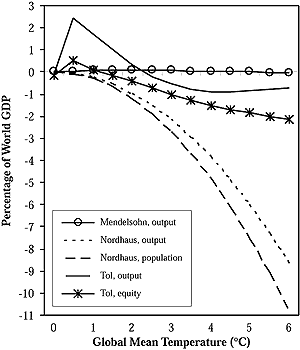19.5.3. Insights and Lessons: Vulnerability over Time

Figure 19-4: Monetary impacts as a function of level of climate change
(measured as percentage of global GDP). Although there is confidence that
higher magnitudes and rates of increase in global mean temperature will
lead to increasing damages, there is uncertainty about whether aggregate
damages are positive or negative at relatively low increases in global mean
temperature. |
One of the main challenges of impact assessments is to
move from the static analysis of certain benchmarks to a dynamic representation
of impacts as a function of shifting climatic parameters, adaptation measures,
and exogenous trends such as economic and population growth. Little progress
has been made in this respect, and our understanding of the time path that aggregate
impacts will follow under different warming and development scenarios still
is extremely limited. Among the few explicitly dynamic analyses are Sohngen
and Mendelsohn (1999) and Yohe et al. (1996).
Some information about impacts over time is available for individual sectors.
Scenarios derived from IAMs can provide comprehensive emissions, concentrations,
and climate change estimates that can be linked to impact models. Table 19-5
summarizes estimates of global ecosystem impacts that were derived from such
a model (IMAGE 2.1—Leemans et al., 1998; Swart et al., 1998). The metric
used is percentage change. The example illustrates the clearly nonlinear dynamics
of nonmarket impacts with different pathways for positive (escalating) and negative
(saturating) impacts. The impact levels in this model evolve gradually, and
there are impacts even at low levels of climate change. Although this finding
is consistent with observed change (see Section 19.2), it is sensitive to the
choice of metric. White et al. (1999), for example, found that carbon storage
in terrestrial vegetation would expand under moderate warming because increases
in productivity are enough to offset reductions elsewhere. They show that as
higher GHG concentrations and magnitudes of climate change are reached, carbon
storage eventually will decline.
Little is known about the shape of the aggregate impact function. Dynamic functions
remain highly speculative at this point because the underlying models provide
only a very rough reflection of real-world complexities. Figure
19-4 provides examples from three studies. Although some analysts still
work with relatively smooth impact functions (e.g., Nordhaus and Boyer, 2000),
there is growing recognition (e.g., Mendelsohn and Schlesinger, 1997; Tol, 2001c)
that climate change dynamics in fact might be more complex and may not follow
a monotonic path. Generic patterns that are emerging include the following:
- Moderate climate change may have positive and negative effects, with most
positive effects occurring in the market sector of developed countries. For
higher levels of warming, impacts are likely to become predominantly negative.
However, the overall pattern is complex, estimates remain uncertain, and the
possibility of highly deleterious outcomes cannot be excluded (medium confidence).
- Impacts in different sectors may unfold along different paths. Coastal
impacts, for example, are expected to grow continuously over time, more or
less in proportion to the rise in sea level. The prospects for agriculture,
by contrast, are more complex. Whereas some models predict aggregate damages
already for moderate warming, many studies suggest that under some (but not
all) scenarios the impact curve might be hump-shaped, with short-term (aggregate)
benefits under modest climate change turning into losses under more substantial
change (e.g., Mendelsohn and Schlesinger, 1997) (low confidence).
Aggregating intertemporal impacts into a single indicator is extremely difficult,
perhaps elusive. The marginal damages caused by 1 t of CO2 emissions
in the near future were estimated in the SAR at US$5-125 t-1 C. Most estimates
are in the lower part of that range; higher estimates occur only through the
combination of high vulnerability with a low discount rate (see Pearce et al.,
1996). Plambeck and Hope (1996), Eyre et al. (1997), and Tol (1999a) have since
reassessed the marginal costs of GHG emissions. Performing extensive sensitivity
and uncertainty analyses, they arrive at essentially the same range of numbers
as Pearce et al. (1996). In the complex dynamics that determine marginal damage
costs, the more optimistic estimates of market damages used in recent studies
are balanced out by other factors such as higher nonmarket impacts and a better
capture of uncertainties. Overall, the SAR assessment still is a good reflection
of our understanding of marginal damage costs; our confidence in marginal damage
numbers remains very low.
|